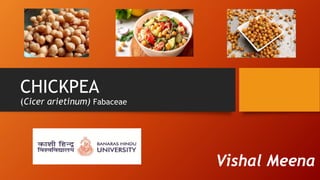India is the largest producer of chickpeas, also known as Bengal gram or chana. Chickpeas are a self-pollinated, annual herb that is high in protein. The leaves and pods contain malic acid and oxalic acid that give them a sour taste and potential medicinal uses. Chickpeas are grown mainly for their seeds, which are consumed in dishes like dhal and used to make snacks and sweets. Major producing states in India are Madhya Pradesh, Maharashtra, and Rajasthan. The crop requires cool temperatures during vegetative growth and warmer weather during maturity. Pests like pod borers can significantly reduce yields and are managed through integrated practices including biological and chemical


























